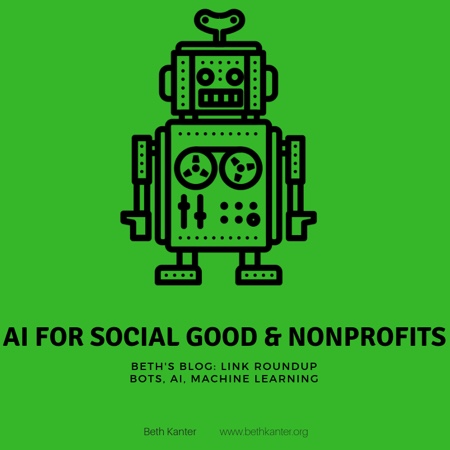
Allison Fine, my co-author for the Networked Nonprofit, and I are actively researching the use of AI for Good, in particular to scale giving and to spread generosity. We are particularly interested in the human side of AI and how it will augment the work of fundraisers and support donors.
This week I interviewed long-time blog reader, Alison Lowndes who I first met via my blog as a regular commenter. We reconnected, of course, through a recent blog comment. Alison founded a nonprofit doing development work in Africa. She is now working the field of Artificial Intelligence, working AI-based solutions to planetary-scale problems.
Among the many insights that Alison shared is that the nonprofit sector needs to think about what they can do that’s more human. AI and ML is all about freeing up staff hours because they are spending less time on tedious, laborious tasks.
She points to a good example in healthcare and how radiologists are using AL algorithms to more quickly (and accurately) analyze scans. Before, the radiologist was spending hours pouring over the data and many scans. But now, AI can analyze many more scans in less time with a great deal of precision. What this does is free up the radiologist’s time to focus on more human tasks – like explaining the diagnosis to the patient.
When we think about applying AI to philanthropy and fundraising, we have to ask this question: What data-based analytical tasks are not yet automated or could be done on a larger scale and that would free up time for the nonprofit staff to focus on the human interaction with the donor?
She pointed an example of using natural language processing algorithms to analyze research papers over the past ten years in a particular scientific field to determine what connections might have been missed. The algorithms also use predictive analysis to make recommendations on future investment in research. What if you could do the same with large amount of fundraising data?
She also offered some advice about designing chat bots, probably one of the easier and early applications of AI that nonprofit will adopt. Alison says the design process has to be human-centric, not technology-centric. There are two sides of the design process. The chatbot has to interact with the target audience. Then need to learn from the analytics that help generate insights so you can make the chat bot more effective.
It is also important to reminder that chatbots should not replace human interaction, but augment it.
This article from charity digital news, How Greenpeace is driving regular donations with Facebook Messenger, describes in detail how they are using humans & Facebook Messenger to increase regular giving. These “instant-messaging using human fundraisers” chat with donors, provide links, may refer them to a chatbot for more information, or donation link.
Much of the growth in fundraising through instant messenger apps has been through chatbots – Greenpeace has been ahead of the game already with its climate change chatbot, but they wanted to test the benefits of real human interaction when engaging supporters. Potential donors can talk about whatever interests them and they are passionate about, with someone equally as passionate as them. Having build that rapport, those human fundraisers can then refer someone to the bot to learn more information.
Each of the six instant messaging fundraisers on the team has four to five interactions on the go at any one time, and are trained and developed to respond quickly. Once someone clicks on a Facebook advert, they go straight into the instant messenger chat. Conversations can go on for anything from five minutes to two weeks (that is the cut off period Greenpeace has imposed for talking to any potential donor) and happen on the basis on that supporter’s own time.
How can AI be used to scale or further automate this type of fundraising. According to the article, having the back-end infrastructure in place is essential to manage multiple chats, hundreds of incoming messages a day, track their impact and learn from the findings. Here is where AI can help – with the learning and tracking. And, even perhaps make suggestions to the human instant messenger fundraisers conversation prompts that might work best to engage and unlock generosity with the donor in the back-end.
AI is a fast developing field and there is a focus on developing what is called – “Artificial Emotional Intelligence.” Developers are working on making the chatbots or virtual assistants more conversational or have empathy as this article describes.
From a strategy point of view, when organizations integrate AI into their fundraising operations – they need determine the right mix of human/machine interaction, incorporate a feedback/learning loop, and how to leverage efficiency.

Leave a Reply